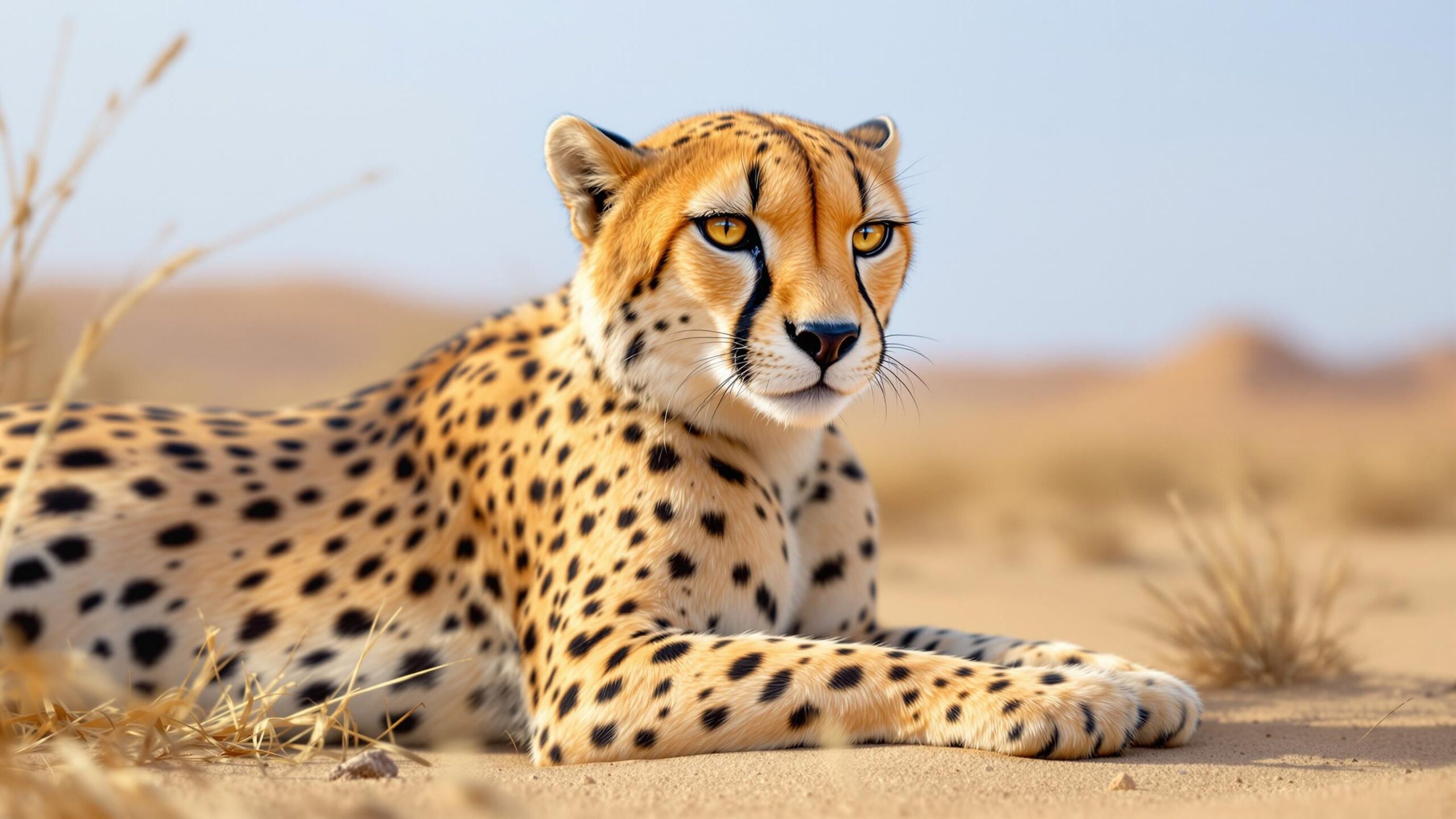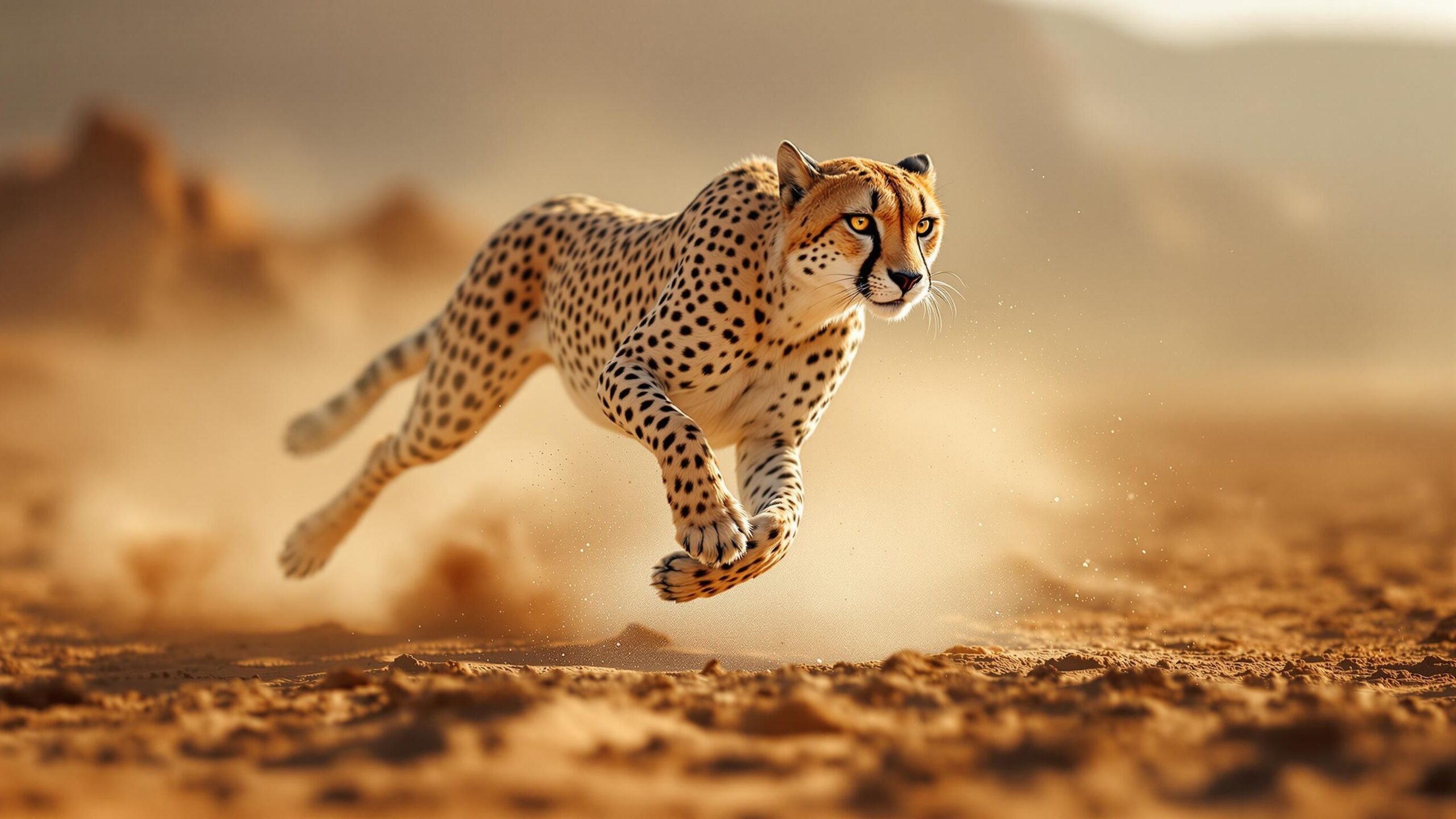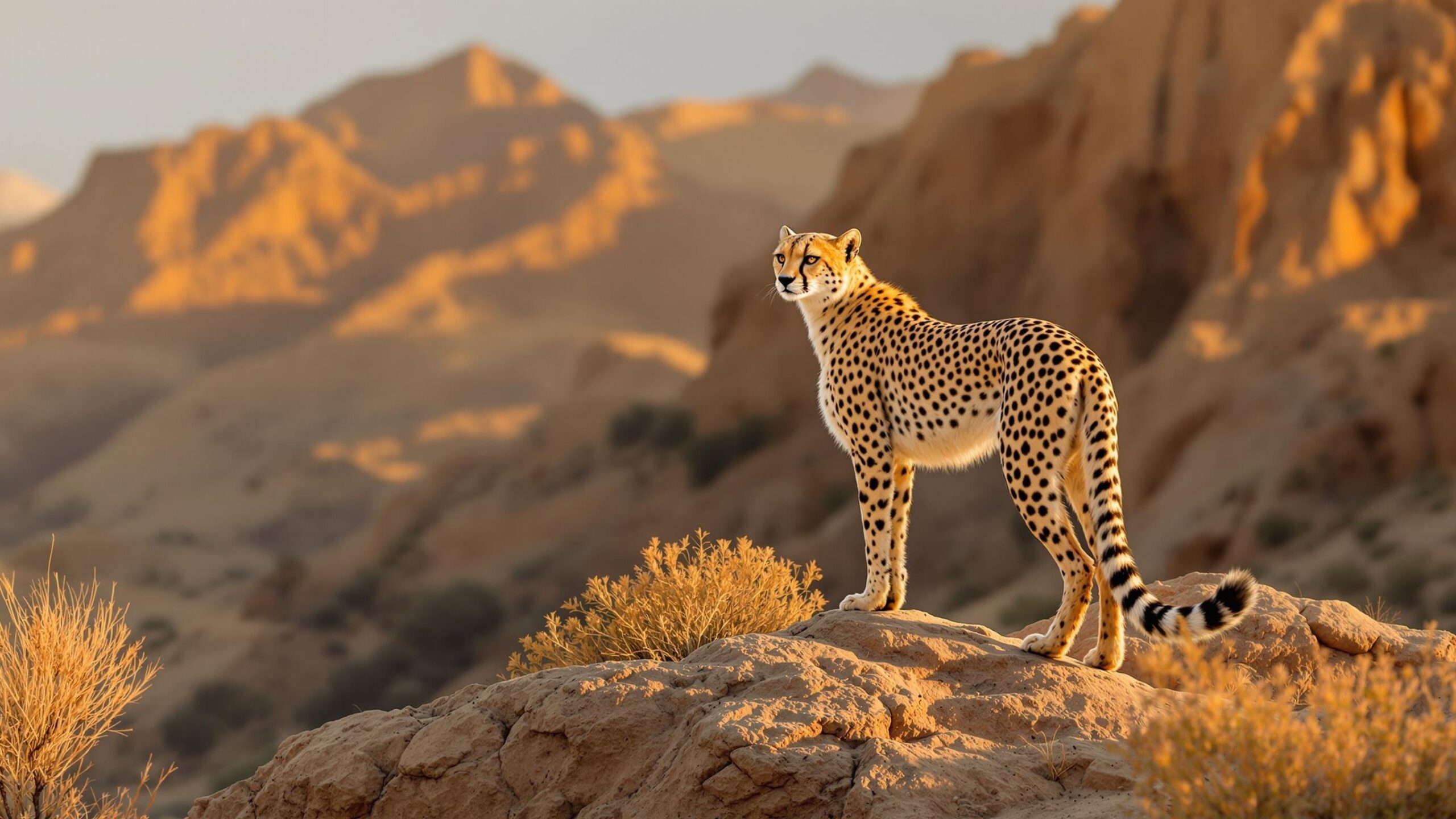The Asiatic Cheetah: Ghost of the Persian Wilds
In the vast, arid landscapes of Iran, an elusive predator lingers in the shadows of its former empire. Known scientifically as Acinonyx jubatus venaticus, the Asiatic cheetah is a critically endangered subspecies of cheetah that once roamed across the Indian subcontinent, the Middle East, and parts of Central Asia. Now, this regal feline’s realm has shrunk dramatically, and fewer than a few dozen remain in the wild—confined almost entirely to Iran. Their story is one of ancient dominance, steep decline, and fragile survival, steeped in myth, ecology, and the enduring hope of conservation.
A Regal Predator from Antiquity
The Asiatic cheetah boasts a rich cultural and ecological history that stretches back thousands of years. Revered by emperors, painted in Persian miniatures, and etched into the legends of Indian maharajas, this feline was once a companion of royalty. The name “cheetah” itself comes from the Sanskrit word chitraka, meaning “speckled,” an ode to the cat’s beautifully spotted coat.
Unlike its more robust African cousins, the Asiatic cheetah is slightly leaner with a paler coat and fewer, more sparsely distributed spots. Their build is still unmistakably cheetah-like: long limbs, deep chest, small rounded head, black “tear marks” running from the inner corners of their eyes to the sides of the mouth—an evolutionary design that reduces sun glare and aids in focus during high-speed chases. While their anatomy makes them the fastest land animals on Earth, capable of reaching speeds of up to 70 miles per hour, the Asiatic cheetah is not just about speed. It is a survivor, a symbol of endurance in one of the harshest terrains on the planet.
An Ancient Range, Now a Fragment
Historically, the Asiatic cheetah’s range was vast. They roamed from the Arabian Peninsula through Iran, Afghanistan, Pakistan, and into India. These open lands—comprising deserts, grasslands, and scrub forests—offered the perfect conditions for the cheetah’s high-speed pursuits of antelope and other fleet-footed prey.
India, in particular, was once a stronghold. The Mughal emperors kept cheetahs as hunting companions, known as “hunting leopards,” and they were a fixture in royal courts. Yet by the mid-20th century, rampant habitat destruction, hunting, and the disappearance of their prey base led to their complete extinction in India. The last confirmed sighting there occurred in 1952.vIn the present day, the Asiatic cheetah’s wild population is restricted almost entirely to Iran’s central plateau, with small groups scattered across the provinces of Yazd, Kerman, and Semnan. These cats have adapted to a life in some of the most rugged and arid environments, surviving where few other large predators can.
Life in the Harsh Heart of Iran
The Iranian deserts might seem like unlikely cheetah territory, but the Asiatic cheetah has evolved to survive in these unforgiving conditions. Their preferred habitat includes semi-desert and arid mountain regions, where they seek shelter in rocky outcrops and scrubby vegetation. Unlike African cheetahs, who often hunt in open grasslands, the Asiatic subspecies has adapted to stalk their prey through more varied and often rugged terrain.
Their diet consists primarily of medium-sized ungulates such as gazelles (especially the goitered gazelle), wild sheep, and wild goats. They are solitary hunters, generally operating at dawn or dusk to avoid the heat of the day. Cheetahs rely on stealth to get as close to their prey as possible before unleashing their explosive sprint. A chase rarely lasts more than a minute, but it is a life-or-death burst of energy that demands precision and timing. One of the more unique aspects of the Asiatic cheetah’s behavior is its cautious interaction with human-modified landscapes. Due to the scarcity of wild prey, some cheetahs are known to approach water sources or grazing zones used by local herders, increasing the risk of conflict.

Physical Features and Characteristics
The Asiatic cheetah, while similar to its African relative, has distinct differences. Adults typically weigh between 70 and 90 pounds, slightly lighter than African cheetahs. Their fur is a lighter, sandy color—an adaptation to Iran’s dusty deserts—and they often appear slimmer, with longer legs and a slightly smaller head.
Cubs are born with a soft, grayish mantle of fur along their backs, which may help them blend into grassy terrain and mimic honey badgers—an example of protective mimicry. Like all cheetahs, they lack the ability to retract their claws fully, which helps them maintain grip during high-speed chases. Though they are built for speed, cheetahs are not the most powerful of predators. Their lightweight build means they are often unable to defend their kills against stronger carnivores such as wolves or hyenas (the latter being rare but present in parts of Iran). They must eat quickly and remain constantly alert, even in success.
Courtship and Cubs
Cheetah reproduction is a solitary affair. Females raise their young alone, and males generally do not participate in rearing. After a gestation period of around 90 to 95 days, a female gives birth to a litter of up to four cubs. These cubs are born blind and helpless, and survival is precarious in the wild. In the harsh Iranian landscape, many cubs do not survive past the first few months, falling prey to starvation or predators. Females often move their cubs frequently to avoid detection, and they rely on concealment and vigilance to protect them. The first year of a cheetah cub’s life is a crash course in survival—learning to stalk, chase, and recognize danger in every shadow.
A Fragile Future: The Conservation Dilemma
With fewer than 50 individuals estimated to remain in the wild, the Asiatic cheetah is teetering on the edge of extinction. In fact, it is considered one of the rarest cats on Earth. Unlike many other endangered animals, the Asiatic cheetah has no known population in captivity, meaning every living individual in the wild is critically important. Iran has made efforts to protect this unique subspecies, including establishing the Asiatic Cheetah Project in collaboration with international organizations such as the United Nations Development Programme (UNDP). Over the years, efforts have included patrolling protected areas, educating local communities, researching the cheetahs’ movements through camera traps, and limiting road construction in sensitive habitats.
However, conservation has faced serious challenges. In 2019, international funding dried up. The cheetah’s primary habitats remain under threat from industrial development, overgrazing by livestock, and an increasing number of roadways crisscrossing once-secluded lands. Vehicle collisions have emerged as a major threat in recent years, with multiple cheetahs killed while attempting to cross highways. Despite these difficulties, hope remains. Iranian scientists, wildlife rangers, and activists continue to push forward, working against the odds to protect the last of these desert phantoms. Public awareness campaigns have increased the cheetah’s profile within Iran, and its image even appeared on the national football team’s jerseys during international tournaments.
The Role of Cheetahs in Ecosystem Health
Though their numbers are small, Asiatic cheetahs still play a key role in maintaining ecological balance within their range. As apex predators, they help control populations of herbivores, which in turn influences vegetation patterns and overall biodiversity. Their presence indicates a relatively intact ecosystem—one where prey species persist and natural processes continue. Losing the Asiatic cheetah would not just mean the extinction of a charismatic cat; it would signify a broader collapse of the arid steppe ecosystems they represent. Their disappearance would be a blow to natural heritage that stretches back thousands of years.
The Question of Reintroduction
In recent years, there has been growing interest in the potential reintroduction of cheetahs into former ranges, particularly in India. In 2022, India launched an ambitious project to bring African cheetahs to several protected reserves, most notably Kuno National Park. While this marked the return of cheetahs to Indian soil after more than 70 years, it sparked debate among conservationists.
Some argue that reintroducing the African subspecies is a poor substitute for reviving the native Acinonyx jubatus venaticus, and that the resources would be better spent aiding Iran’s dwindling population. Others contend that, given the dire situation, any return of cheetahs to South Asia is a step in the right direction. Ultimately, these projects underscore the immense public interest and symbolic power that the cheetah—Asiatic or African—still commands.

The Cultural Echo of a Vanishing Cat
The Asiatic cheetah is not merely an animal; it is a symbol of lost grandeur and natural wonder. It appears in Persian poetry, Mughal paintings, and even in the fabric of local myths. Stories tell of cheetahs racing beside kings, leaping into action at a hand signal, or vanishing into the golden sands like spirits.
Today, these stories carry added poignancy. The cheetah has become both a legend and a rallying cry—a reminder of what once was and what still might be saved. Across Iran, conservationists have invoked national pride to protect the animal, positioning the Asiatic cheetah as a symbol of resilience and cultural identity.
Why the Asiatic Cheetah Matters
Preserving the Asiatic cheetah is about more than just protecting a species; it’s about safeguarding a unique evolutionary lineage. As the last surviving representatives of their subspecies, these cheetahs hold genetic, ecological, and historical significance that cannot be replaced.
Their fate will likely be decided in the next few decades. Without bold conservation action, strategic habitat management, and international support, the story of the Asiatic cheetah could soon be consigned to history books. But with perseverance, innovation, and cooperation, this ghost of the Persian wilds might yet roar—softly and swiftly—into the future.
Final Thoughts
The Asiatic cheetah is a creature of elegance, endurance, and ethereal beauty. Its story is one of both tragedy and tenacity, echoing through ancient empires and modern conservation corridors. It may be rare, but it is not forgotten. And so long as it runs—silent and swift beneath the desert sun—it remains a living link to the wild heritage of Asia.

